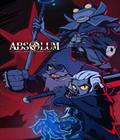August 11, 2011
Eidos Montreal
We're on site at Eidos Montreal today, checking out the final version of Deus Ex: Human Revolution and spending time chatting with the developers to get an inside view. Although our review is embargoed for another week or so, Square Enix said everything else was up for grabs. We'll be updating this post throughout the day, as well as updating the official WorthPlaying Twitter feed. Bookmark this page and follow us on Twitter for live updates. You can also tweet us specific questions for the developers, and we'll try to answer the most interesting ones.
1:30 PM
Gameplay Hands-On: The Hive and the Whorehouse
The Hive is one of the most popular destination in the Hengsha city hub. It's run by Tong Si Hung, otherwise known as Mr. Tong.
We could have gone in the front door, but that might have gotten noticed. Better to sneak in the back, via a vent in the alleyway. Sure, it means entering through the women's room, but hey, you do what you gotta do.
Listening in on the patrons at the Hive reveals a bit about the Harvesters. It seems they are a gang that acquires augmentations by literally ripping them out of others.
We upgraded Jensen's hacking skills to break into a restricted area in the basement. That's where Mr. Tong's office is located. There's some Chinese writing here. Wonder how accurate it really is. Some patrons in the club speak Chinese as well. Their subtitles show in English, though (or else we'd be screwed).
Damn. This lock requires you to hack dual nodes. Just getting one doesn't do the trick. Looks like we have to head upstairs for a chat with the manager; otherwise, hacking the lock to the restricted area sets off an alarm that brings the guards running.
Ha! The Chinese manager insults Jensen by calling you a "gwailo," which is a racial slur meaning "white man." He really doesn't like Jensen, but our persuasive skills get him to unlock the basement door for Jensen.
Hacked into a second area and snagged a PDA from the DJ. Found some useful stuff, so remember this when you play through the game. It might save your ass. The basement access code for the Hive is 0415. The access code for the security room is 8953. Don't say we never did anything for you.
Down in the basement, we made our way to Tong's office to have a chat. He was kind enough to reveal the location of the hacker that's been harassing Sarif Industries. How nice of him. Wonder if there is a hidden agenda at play here?
As we were leaving, the bouncer grabbed Jensen and advised getting a drink from the bartender before leaving. The bouncer is having trouble with a woman named Jaya, who owes money to Mr. Tong. He wants you to hack three cell tower relays so that Jaya's position can be triangulated. It's one of the side-quests in this area. Accepted it, but probably won't play through it right now.
On the way over to the Alice Garden Pods Jensen runs into Malik, who seemed quite upset. She's working on her own side project, trying to determine who murdered a friend of her and why the police covered it up. It's another side-quest, but it just confirms what we already suspected about Human Revolution: Conspiracies are everywhere.
Once Jensen finds the hacker who attacked Sarif Industries, he reveals that he was only working on contract. The one pulling the strings (and paying the bills) was the head of Sarif's biggest competitor, Tai Young Medical. Since the failed op, Tai Young Medical burned the hacker and put a bounty on his head. As a result, he didn't have too much of a problem giving Jensen some information — specifically, what you need to collect to sneak into Tai Young Medical. Our first stop is the Hung Hua Hotel, AKA a local whorehouse.
One of the working girls tells you that another girl has been kidnapped by the owners as they want the girls to get augments to bring in more money from customers. The kidnapped girl refused augments in the past, and her friend fears that the owners will augment the girl against her wishes.
After accepting the mission, our time with the game was over. The PR rep — Hi, Matt! — herded us out of the office to get ready for dinner. The good news is that we're walking away with a retail copy of Human Revolution, so we can schedule more time with the working girl next week.
12:30 PM
Frank McCann (level designer) JF Champagne (level designer) — Multipath Options and Side-quests
The primary goal was to give players the option to play the way they wanted to play. Some of the options are tricky and risky, but it's doable. Upgrading weapons and augmentations will give you an edge, but none of them are necessary.
The first thing the developers laid out when developing side-quests was that they wouldn't just be filler. Every side-quest is either very important, deals with somebody you care about or is very interesting from a story perspective. The focus was on quality over quantity, where playing each side-quest reveals more about the world.
You are free to play all of the side-quests or none of them. How you approach side-quests can have an impact on the later game, as your efforts in the early game will have repercussions. Just like the primary quests, your choices are important. Nothing in the game should feel like a throwaway element.
It is also possible to close off possible side-quests by killing a key character before the quest is available. Unlike the core missions, side-quests are not considered essential, and the game will not prevent you from inadvertently locking yourself out of one.
Counting the side-quests separately from the primary story path, we're told that they add approximately 12-15 hours of gameplay. That's a lot of optional content that is sure to appeal to player who wants to really delve into the lore of the Deus Ex world.
After talking a bit, the two developers wanted to give us a practical example of some of the multipath gameplay in the Detroit city hub. We took a look at the assault on a gang hideout, exploring each of the different paths. First they went for a full-on frontal attack, with guns blazing. This got the AI worked up, and it was a good way to show off how both the alert and cover systems worked. Using available cover and line of sight, our intrepid demo agent ducked behind some random trash while the AI guards furiously searched for him. Then, with a little backtracking, he showed off a few of the different ways he could have snuck in and avoided the guards entirely.
Difficulty level impacts the health points of the AI characters. There are not different amounts of characters; they are simply harder or easier to kill. They do not get smarter.
The two developers emphasized that Deus Ex: Human Revolution is a tactical shooter. This means that if you do decide to go head-on with enemies, even with combat augmentations, you have to be smart about it. Just pulling out your weapon and charging in like Rambo means that you're likely to get shot to pieces.
11:45 AM
Level Design and Stealth Gameplay Demo with René-Martin Pauzé (Lead level designer) and Julien Hantz (Senior Level Designer)
After the hacking and social demo, we ducked into a meeting room with René-Martin Pauzé and Julien Hantz to talk about the level design and stealth gameplay aspects of Deus Ex: Human Revolution.
One of the first things they told us is that they wanted to ensure that stealth players were rewarded since it takes a lot of work to stay hidden versus just powering your way through with a gun. If you are a total ghost, you will get more experience.
If you are not noticed, the NC patrols stay relaxed. They are easier to avoid. Once you are detected, the AI gets suspicious and aggressive. They will call alarms so other people can come out to find you. Alarms stay in the local area.
Stealth gameplay and combat are both based on the cover system. They do not rely on shadows; instead, it is all about line of sight. Each level has a stealth path, with cover.
One thing that was particularly difficult when creating a level in Human Revolution was the simple fact that the developers had no idea which augments a given player would have unlocked at that point. They had to make sure that there was a path through no matter what. In fact, they said one of the requirements was that you be able to play through the entire game without enabling any augmentations. It's much more difficult to do so, but it is possible.
We were also told that you can play through all of Human Revolution as a completely stealth game. If you're good enough, the only required combat sequences are the boss fights.
Crossbow is a useful weapon if you're going for stealth, as it is a silent weapon.
There are a decent number of alternate paths and hidden rooms that can be opened up by using the punch-through wall augmentation. This is a context-sensitive augmentation, so if you have it, you can see the walls that are possible to break through. If you do not have the augmentation, you can still break down the wall with weapons (every breakable wall has its own health meter), but you will not see any obvious notation that it is destructible. You will have to look for subtle clues.
At this point, the developers switched into a gameplay demo, showing off one of the levels we played in our hands-on preview. They were highlighting all the different possible ways to approach the first mercenary camp, right outside the entrance of the underground F.E.M.A. base.
The key takeaway was that there is always a way to bypass a situation. You can always fight, but unless it is a boss encounter, you are never required to do so.
When designing levels for each area, the developers targeted an average of one hour of gameplay time. Since each level has multiple paths, someone who is trying to explore every single path through can easily take much more time. Just like in real life, the physical size of a level can be much bigger than the quickest path requires.
11:00 AM
Frank Lapikas (Senior Game Designer) — Hacking and Social Demo
First task at hacking was a lot more complex. Play-tested the original concept for three months, but it was too complex for testers. "They just didn't know what was going on." The developers had everything recorded in Excel and used that to test out the paths for the hacking minigame before actually coding it into the game.
A former UI designer came up with the current representation of the network. The team at Eidos Montreal wanted to make sure it was visual and easy to understand.
All of the computers in a given level are on the same network. This is shown through e-mails as well as the security systems, where you can log into a computer in one area and take control of security cameras and robots in another area. Security cameras and sentries can be used, shut off, etc.
Every device has a specific password. If you know the password (say, from a prior playthrough) to a machine you can enter it in, even if you've not "found" it in the game during that playthrough.
Basis for the conversation with Wayne at the police station was created after Lapikas broke up with his girlfriend. He came into the office the next day and used that emotional background to generate the core of Wayne and Jensen's backstory.
When talking to characters, you get one shot for key conversations. If you piss off a character, that's it. There is no chance to try again unless you reload a prior save. Conversations have an element of randomness in them as well, so even if you reload a save, you may not get the exact same options.
"Winning" a conversation can be made easier by using the social augmentation, as that will give you direct feedback on what the AI character is feeling and thinking, making it easier for you to read them and therefore manipulate them.
Much like the hacking bits, all of the key conversation paths were prototyped in Excel with a Visual Basic front end. Gameplay testers went through the conversations in Excel before they were finalized and approved for inclusion in the game. Once approved, conversations were sent out for audio recording and programmed in.
Conversation is basically a "rock-paper-scissors" mechanic.
You can go off-script in most of the game. However there are a limited number of main characters that cannot be killed off until they are no longer needed.
You will make multiple visits to each hub in the game, but the game decides when you come back. You cannot manually move from hub to hub.
According to Lapikas, each of the multiple endings are distinct, but all of them allow for the setup of the original Deus Ex. In creating Human Revolution, they used a story bible, but also constantly referred to the original game to ensure world consistency. The developers behind Human Revolution know that the original Deus Ex did a lot of things right, so they tried to keep the good stuff while adding what they felt was missing and changing the things that they thought Deus Ex didn't do right.
10:00 AM
Arrived at Eidos Montreal. Who knew there was a booze shop right next door? http://post.ly/2qfpu
After checking in at the front desk, we headed into a conference room for breakfast and an overview of the day. Most of what they covered was the basics, which you can find in our hands-on preview, but we got one new tidbit confirmed, and that has to do with upgrades.
If you get all of the upgrade points in the game (Praxis points), you will only be able to unlock about 70-75% of the augmentations. Most players will unlock less. The idea is that the developers want you to be able to play through the game a second time and try a completely different style.
Unfortunately, there is no New Game Plus option with the ability to keep your existing augmentations. If you want to try a new augmentation path, you are starting over from the beginning.
After the demo, we're splitting off into three different breakout sessions for more details on specific systems.
More articles about Deus Ex: Human Revolution











 In Deus Ex: Human Revolution you play Adam Jensen, a security specialist, handpicked to oversee the defense of one of America's most experimental biotechnology firms. But when a black ops team breaks in and kills the scientists you were hired to protect, everything you thought you knew about your job changes.
In Deus Ex: Human Revolution you play Adam Jensen, a security specialist, handpicked to oversee the defense of one of America's most experimental biotechnology firms. But when a black ops team breaks in and kills the scientists you were hired to protect, everything you thought you knew about your job changes.